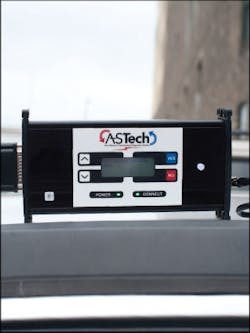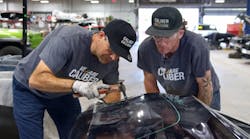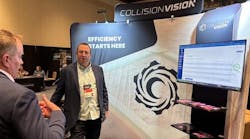Advanced Diagnostic systems are among the newest technological hurdles facing collision repair shops. New model vehicles have an average of 20–30 modules overseeing operation of various electronic systems and components that may need to be addressed during the repair process, and high-end makes like Lexus have more than 90. There is no way your shop can ensure a full, accurate and proper repair without the ability to diagnose those components.
To date, there have been three main strategies for shops to complete the diagnostic process—purchase aftermarket scan tools, purchase OEM scan tools, or send vehicles to the dealership—each of which comes with a separate set of advantages and challenges: Aftermarket scan tools can be affordable but aren’t always accurate; OEM scan tools are accurate but extremely expensive; and outsourcing to the dealership offers quality information but can hurt cycle time and the bottom line.
In a perfect world, shops should be able to diagnose every vehicle using one affordable tool that provides OEM-level accuracy directly inside their own facility. It sounds like a pipe dream, but it’s possible today with a new Internet-based diagnostic system called the ASTech—a tool that some repairers say has revolutionized their diagnostic process. They’re making faster, higher quality repairs, and saving money along the way.
How It Works
The vehicle diagnostic process through the ASTech system takes minutes, and requires no additional time from staff.
Here’s how it works:
After a job comes in, repair shops plug the ASTech into the vehicle’s OBD-II port and email or fax the vehicle’s information—including VIN, make, model and year—to Automotive Electronic Solutions (AES), developer of the ASTech. The vehicle’s module information is sent through the Internet to a team of seven OEM expert diagnostic technicians based in AES’s corporate headquarters in Jacksonville, Fla.
The technicians—who each specialize in certain manufacturers—perform a full diagnosis of every vehicle module, and email a detailed, itemized report back to the shop within 30 minutes. Meanwhile, your shop’s technicians are free to attend to other business.
AES recommends that shops perform two diagnostic scans: one before vehicle disassembly to identify all module problems and codes that need to be fixed, and one post-repair to ensure new codes were not thrown during the repair, to clear out any remaining issues, and to finalize the job.
The ASTech is a Web-based system, so your shop’s Internet must be operational for it to function. In situations when the Internet connection is down, the ASTech also works using a hotspot device. The company’s diagnostic center operates from 7:30 a.m. to 8 p.m. EDT in order to accommodate business hours of shops nationwide.
Problem Solver
Three shop operators share how the ASTech has resolved their most significant problems with the diagnostics process.
PROBLEM #1: High Cost of OEM Scan Tools
Kyle Wiersma, vice president of Randy’s Body Shop in Paducah, Ky., purchased two scan tools for his shop. He bought one aftermarket tool that covered several vehicle makes, but needed one OEM tool specific to a certain make he fixed often.
The device cost $10,000, plus $1,200 of annual update requirements to continue using it.
“We’re talking big money,” he says, noting it’s very difficult to acquire a full return on the investment.
Jake Rodenroth, manager of collision services for Automotive Electronic Solutions, developer of the ASTech, says that’s not uncommon. OEM tools cost a minimum of $5,000, and up to $30,000 for a Mercedes-Benz system. All of them come with weekly, monthly or annual updates.
ASTech Solution: The only device shops need to operate the ASTech system costs $2,495—a one-time fee with no annual updates. The tool gives shops access to more than $170,000 worth of factory-level OEM diagnostic scan tools.
Shop Improvement: Wiersma says he no longer has to calculate his ROI on the expensive OEM tools; the AES diagnostic service can now be billed out on a per vehicle basis. In addition, he doesn’t have to consider purchasing OEM-level devices for vehicle models he rarely fixes.
“The price is good for dealership-level scans. I have blown a whole lot more money on other scanners that I’ve never really even used,” he says. “This tool is a whole lot cheaper and very practical financially.”
PROBLEM #2: Slow Updates to OEM Tools
Matthew McDonnell, owner of Big Sky Collision Center in Billings, Mont., says OEM scan tool updates are slow to become available to independent shops. He doesn’t get information for 2013 models until the new 2014 models are out. Since he’s always one year behind, brand new vehicles still have to be sent to the dealer.
ASTech Solution: The ASTech works directly with each auto manufacturer, and receives all updates and information at the same time dealers do.
Shop Improvement: McDonnell never has a reason to go to the dealership for any model vehicle, and he doesn’t have to worry about purchasing an OEM update.
PROPLEM #3: Poor Accuracy of Aftermarket Scan Tools
Because OEM tools are so expensive and specific to manufacturers, Hal Davis, facility manager at Collision Solution in Chicago, opted to purchase an aftermarket scan tool that covers a majority of the vehicles his shop repairs.
The tool worked to scan dash codes, but usually missed other electronic components in the car that don’t have dash codes, such as Bluetooth or door locks. He says it was common to get to the end of a repair and realize that a certain component wasn’t working. Vehicles habitually had to be sent to the dealer at the last minute, a cost the shop often wouldn’t be reimbursed for because the estimate had already been uploaded and locked.
—Hal Davis, facility manager, Collision Solution
That’s a notorious problem, Rodenroth says. Aftermarket tools are limited in scope, and known for missing collision-related items on the perimeter of vehicles: parking sensors, blind spot protection, adaptive cruise control and adaptive headlights.
ASTech Solution: The ASTech provides shops with factory-level diagnostic capabilities for almost every vehicle they repair. The tool currently covers Acura, Audi, BMW, Cadillac, Chevrolet, Dodge, Chrysler, Jeep, GMC, Honda, Hummer, Infiniti, Lexus, Toyota, Scion, Mercedes-Benz, Mini Cooper, Nissan and Pontiac.
Rodenroth says Ford, Hyundai, and Kia are expected to be added to the system by the end of the year.
Shop Improvement: Davis no longer has to worry about repair quality, comebacks, customer service or liability issues caused by inaccurate or incomplete information.
“I have a lot more faith in this tool regarding the accuracy and quality of information compared to any other option,” he says.
PROBLEM #4: Operational Inefficiencies Outsourcing to Dealers
The closest high-end dealerships to McDonnell’s facility in Montana are located in Denver, Minneapolis and Seattle.
He says every time his shop works on a Jaguar or Land Rover, the vehicle has to be put on a trailer and driven to Denver—a one-day drive each way. It’s a cost of $2,400, and adds at least three days of cycle time onto those repairs. And cycle time could be delayed even longer depending on the dealership’s work schedule.
ASTech Solution: The ASTech diagnostic process is completed inside your own facility within 30 minutes.
Shop Improvement: McDonnell says avoiding dealerships has literally shaved multiple days off cycle time for every car that requires diagnostics. It’s also much easier to calculate and manage repair deadlines when you don’t have to deal with the variables of an outside business.
PROBLEM #5: Insurers Won’t Pay for Diagnostics
Wiersma knows every vehicle he repairs should go through the diagnostic process. Although diagnosing every car is an essential precaution to guarantee a full repair, the effort also comes with a financial gamble.
Dealers charge shops for diagnostics regardless of the results, but Wiersma says insurance companies don’t reimburse the expense if nothing is found. They claim diagnostics to be an unnecessary process if no dash lights are on.
That leaves Wiersma in a difficult conundrum: don’t scan the vehicle and risk potential quality and liability issues, or scan the vehicle and risk financial loss.
ASTech Solution: The current cost of the ASTech diagnostic scans are $85 each for the pre- and post-repair scans. But Wiersma says when a problem is revealed, which is the case about 90 percent of the time, he’s having no trouble adding the charge to repair orders because he has the right documentation to prove it.
He explains how much time and money the shop is saving by eliminating towing and sublet work, and so far, insurers have been happy to cover the cost to improve cycle time and reduce claim severity.
“Insurers understand that anything we can do in-house, the better the process will be,” Wiersma says.
Shop Improvement: Because the ASTech charges are offset on estimates, Wiersma says use of the system is essentially free.
Wiersma says he’s now able to diagnose every vehicle to gain confidence in repair accuracy with reduced financial concerns.
PROBLEM #6: Don’t Know What Codes Mean
Davis says the scan tools he purchased in the past would provide him with a list of codes to address, but they didn’t break the problem down and highlight the specific steps to take during the repair.
For example, if an airbag had deployed, his scan tool would only identify the fact that the vehicle needed a new airbag. It didn’t highlight each step to fix it, such as checking clock springs, checking steering columns or resetting sensors.
“We constantly had to do more research to identify the exact issue, and sometimes call the dealer for information,” Davis says.
ASTech Solution: The ASTech system provides shops with a full, itemized printout of each module that needs to be addressed, and every specific process that needs to be completed to fix the component.
Shop Improvement: Davis says this has allowed his staff to develop more complete repair plans. The shop has nearly eliminated situations when a code or light still exists at the end of the repair for an unknown reason.
That printout also allows Davis to more easily document necessary work that the shop will perform, which improves relations with insurance companies and justifies the charges.



